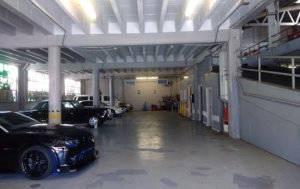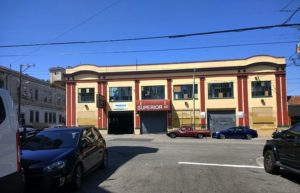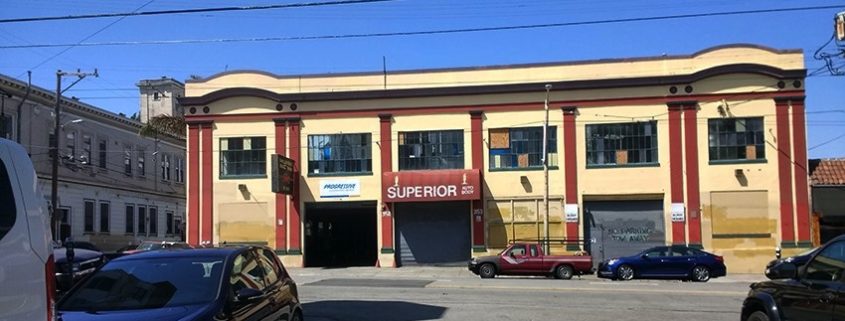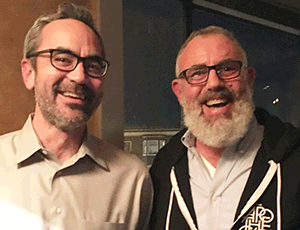SF Mission historical auto livery adjusts — or not — to the 21st Century
For nearly 100 years, the Superior Auto garage has visually dominated the corner of 16th and Albion streets. Built by famed architect Joseph L. Stewart, the monumental garage was built to herald the arrival of the single-occupant automobile, San Francisco’s newest transit option after 1906.
They were built to park and repair cars in a city whose apartment buildings had no garages and, in a nod to the more-familiar horse stables, they were called “auto liveries.”


Nowadays, however, historic buildings — beloved by preservationists for the classic beaux-arts formalism that characterized the post-earthquake period — can pose a challenge for developers and housing-rights advocates.
Superior Auto is a case in point. Sold four year ago to developer Manouch Moshayedi, head of MX3 Ventures, a family-owned real estate and development firm based in Newport Beach, California, for $8.7 million dollars, it seemed perfect for housing.
The firm proposed to demolish the 2,024-square-foot site and build a five-story, 28-unit housing development in its place.
That plan failed when the Mission Dolores Neighborhood Association wrote a letter to Phil Lesser, past president of the Mission Merchants Association and community liaison for the project, objecting to the proposed demolition.
“The city backed us up,” said Peter Lewis, president of the board of the neighborhood association. The city’s Historic Preservation staff, led by Tim Frye, had already categorized Superior Auto as a “Grade A” historic building and a key element in the 16th and Valencia street post-fire historic district.
Moshayadi came up with a new plan. The proposed building would be re-purposed and transformed into an event site. The building’s stucco exterior and design features would be repaired and restored. Three restaurants would occupy the ground floor, with an event space on the second floor.
A section of the undulating, wave-shaped roof would be leveled to accommodate a deck for a rooftop bar and movie screen.
The proposed name of the venue? “The Albion.” How far this goes on a block already lined with bars, is unclear. Its history, however, is set.
The future home of the proposed venue started life as an undeveloped parcel on Center Street, the 19th-century name of 16th Street, which got its name from its centrality to navigating the swampy flatlands of Mission Creek.
In 1907, Ada F. Simpson sold her parcel on the corner of 16th and Albion to Rudolph Taussig, president of the Louis Taussig Company, a wholesale wine and liquor business, which also owned the adjoining parcel of land. “This gives the Taussig family 100 feet on Sixteenth Street on which they will erect a two-story building for their increased business,” noted the San Francisco Chronicle.
Taussig hired San Francisco architect Joseph L. Stewart, who was busy building other monumental auto garages in San Francisco. At least two still exist: the Hub Garage Company on 150 Turk St., and a warehouse for the Michelin Tire Company at 180 12th St., now the European Collision Center.
These garages, with their vast, shed-like interiors and marquee-like ornate frames, give a sense of the opulent glamour as automobiles rolled out and onto the streets.
Most of these garages have been demolished or drastically redesigned, Mark D. Kessler, associate professor of design at UC Davis, writes in his book The Early Public Garages of San Francisco, An Architectural and Cultural Study, 1906–1929.
A conditional-use permit is needed before the redesign of Superior Auto gets underway. The San Francisco Planning Department, which accepted the application for a conditional-use permit in July, has yet to schedule a hearing.
Approval by the Mission Dolores Neighborhood Association and other merchants is pending as well. Lewis, who noted that the group has yet to vote, sounded guardedly optimistic. “We support adaptive reuse and quality new construction, as long as no historic building is demolished,” he said, noting that they had no objections to housing. “There’s nothing to stop them from putting housing there,” Lewis pointed out. “It’s their choice.”
Neighbors were informed of the change of use for the site at a December meeting. Lesser contends that support for the plan was high. “We had a lot of people from Albion Street there. And what we heard from them was that they’re anxious to have an occupied building. An empty building is a magnet for quality-of-life problems.”
Unsurprisingly, the project has its critics. The parcel falls within the Valencia Street Neighborhood Commercial Transit District, a designation assigned to locales that need affordable commercial developments.
Peter Papadopoulous, media coordinator for Cultural Action Network, is unsure that another restaurant achieves that goal, pointing out that wine bars and expensive restaurants crowd out inexpensive restaurants, as well as neighborhood services — cleaners, printers, the staple service retail of any neighborhood.
“We’d prefer spaces with modest price points,” Papadopoulous said. “We’re concerned about the sheer number of restaurants opening in that area, and the loss of neighborhood services when higher price point retail opens.
Jessica Flores, who works across the street at Ampersand, a florist’s shop, attended the December meeting. She has mixed feelings. “There have been so many proposals for that place,” said Flores. “It fits the new Mission, not the old Mission.”
Brett Critchlaw, owner of Juice, an advertising firm whose offices are upstairs from Kilowatt, wondered where the restaurant workers would live. “I like the idea of below-market-rate housing. I think it would be better to build housing, especially for workers.” He gestured across the street. “Where are the people who will work there going to live?”



Leave a Reply
Want to join the discussion?Feel free to contribute!